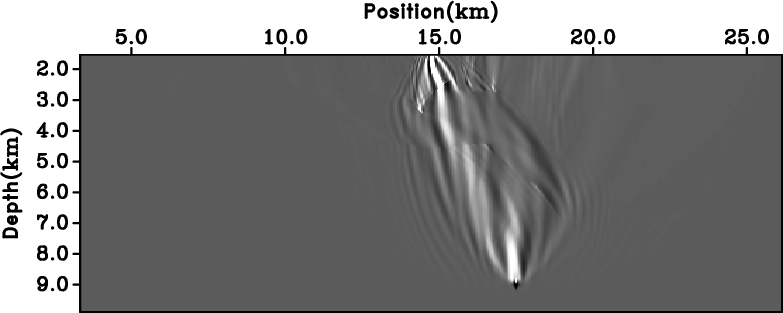A new paper is added to the collection of reproducible documents:
Interferometric imaging condition for wave-equation migration

Interferometric imaging condition
December 2, 2008 Documentation No comments
Wave-equation migration velocity analysis
November 26, 2008 Documentation No comments
A new paper is added to the collection of reproducible documents:
Numeric implementation of wave-equation migration velocity analysis operators

Seismic velocity estimation using time migration
November 7, 2008 Documentation No comments
Velocity analysis using AB semblance
November 7, 2008 Documentation No comments
A new paper is added to the collection of reproducible documents:
Velocity analysis using AB semblance

Making the leap to open source
November 6, 2008 Celebration No comments
Madagascar gets mentioned in an article by Layton Payne from dGB Earth Sciences in the E&P magazine.
Ahay!
October 21, 2008 Celebration No comments
 If you suffer from dyselxia or find it difficult to spell “reproducibility”, there is a shorter name for the new Madagascar website: ahay.org. Thanks to Nick Vlad for creating a mirror. Origin of the name: Ahay is the Malagasy name for aye-aye, a strange nocturnal primate that lives in Madagascar. If you have seen the Madagascar movie, you may remember Maurice the Aye-aye character (voice by Cedric the Entertainer).
If you suffer from dyselxia or find it difficult to spell “reproducibility”, there is a shorter name for the new Madagascar website: ahay.org. Thanks to Nick Vlad for creating a mirror. Origin of the name: Ahay is the Malagasy name for aye-aye, a strange nocturnal primate that lives in Madagascar. If you have seen the Madagascar movie, you may remember Maurice the Aye-aye character (voice by Cedric the Entertainer).
A journal requires a particular font (e.g. Arial or Helvetica) in figure labels. How do I achieve that?
October 15, 2008 FAQ No comments
Update: If you generate Geophysics manuscripts using rsf.tex, the font change should happen automatically. Otherwise, use font= parameter.

See also:
Inverse B-spline interpolation
October 13, 2008 Documentation No comments
Another old paper is added to the collection of reproducible documents:
Inverse B-spline interpolation

Wiki
October 13, 2008 Celebration No comments
Thanks to Nick Vlad, the wiki page moves to a new location and is open for editing.
SLIMpy: SLIM-UBC’s Python interface to Madagascar
August 6, 2008 Systems No comments
In the light of the recent discussion on extending the Python interface to Madagascar, I would like to inform those of you who did not know already about the public release of SLIMpy: SLIM-UBC’s Python interface to out-of-core seismic data processing.
SLIMpy is a Python interface that exposes the functionality of seismic data processing packages, such as MADAGASCAR, through operator overloading. SLIMpy provides a concrete coordinate-free implementation of classes for out-of-core linear (implicit matrix-vector), and element-wise operations, including calculation of norms and other basic vector operations. The library is intended to provide the user with an abstract scripting language to program iterative algorithms from numerical linear algebra. These algorithms require repeated evaluation of operators that were initially designed to be run as part of batch-oriented processing flows. The current implementation supports a plugin for Madagascar’s out-of-core UNIX pipe-based applications and is extenable to pipe-based collections of programs such as Seismic Un*x, SEPLib, and FreeUSP. To optimize performance, SLIMpy uses an Abstract Syntax Tree that parses the algorithm and optimizes the pipes.
The main features of SLIMpy include:
– Powerful interpreted programming language (Python)
– Syntax (through overloading) close to pseudo-code for numerical linear algebra
– Abstract Syntax Tree analyzer/optimizer (including command rearrangement form improved performance)
– Concrete linear operator and vector classes, including dottests, domain-range and type checks
– Elementwise reduction-transformation operations (norms, elementary math)
– Compounded linear operators
– Augmented linear operators and vector classes
– Plugin mechanism for Unix pipe-based collections of (seismic) data processing programs
– Parallel execution of reduction/transformation operations
– Parallel execution of embarrassingly parallel linear operators (block diagonal)
– Integration with SCons
– Automatic cleanup of temporary datafiles (garbage collection)
– In-code documentation through Doxygen
SLIMpy is an academic research code that we share with the community through this alpha release. By making SLIMpy available as open source, we hope to create an active community to further develop this software.
SLIMpy is released under GNU Lesser General Public License, and it is available for download from SVN repositories:
– the core packages from https://wave.eos.ubc.ca/Public/Public.Software.SLIMpy/
– the contributions from https://wave.eos.ubc.ca/Public/Public.Software.SLIMpy-contrib/
Additional documentation and tutorials can be found at
– SLIMpy’s documentation http://slim.eos.ubc.ca/SLIMpy/
– SLIMpy’s tutorial http://slim.eos.ubc.ca/SLIMpy/exampleset1.html
Through this release, we hope that SLIMpy can grow into a widely-used Library, supplementing the functionality of currently available processing-flow oriented (seismic) software packages. Please, use SLIMpy-user (http://slim.eos.ubc.ca/mailman/listinfo/slimpy-user) mailing list to report concerns and exchange the ideas. Those of you, who wish to contribute to development, please, subscribe to SLIMpy-devel (http://slim.eos.ubc.ca/mailman/listinfo/slimpy-devel).
Most of the credit for developing SLIMpy goes to Sean Ross-Ross of the SLIM group.
